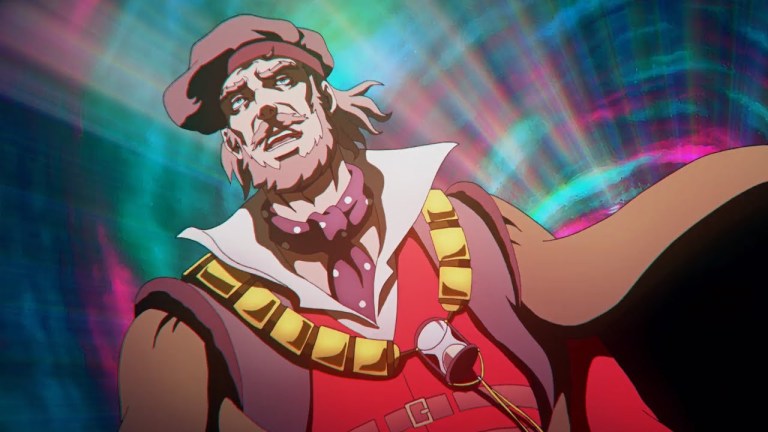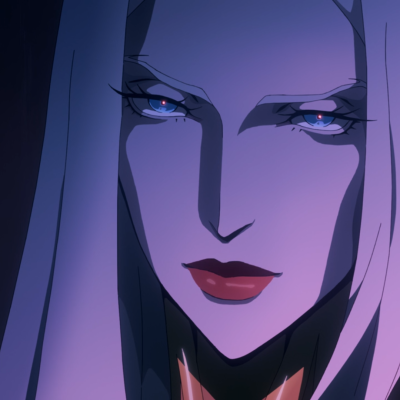Castlevania Season 3 Easter Eggs Explained
Castlevania season 3 is full of easter eggs and references to the video game series and real-life history. Here are all the nods we've found so far!

This Castlevania article contains spoilers.
Castlevania season 3 has arrived with plenty of new characters, locations, and monsters for fans to obsess over. While many of the latest additions to the world of Castlevania are original creations for the show, there are quite a few that are references to the video game series, including characters like Count Saint Germain and The Captain.
If you want to know more about the many easter eggs and nods to the video games in season 3, check out our guide below:
Lindenfeld
Like many of the locations featured in the Castlevania animated series, the village of Lindenfeld is based on a real place in Romania and is described as an abandoned “phantom village” by some. It was once home to shepherds until the Russian Revolution and World War II forced the small population to relocate.
Lindenfeld has never appeared in a Castlevania video game.
Count Saint Germain
The mysterious Count has both gaming and historical origins. In terms of the games, the enigmatic Saint Germain first appeared in 2005’s Curse of Darkness for the PlayStation 2 and Xbox. The game also happens to star Hector on a mission to kill Isaac. Along the way, Saint Germain aids Hector, while also trying to dissuade Hector from following through with his quest for revenge (Isaac gets Hector’s wife killed before the start of the game).
While his origin is never fully explored, it’s strongly hinted that Saint Germain has seen the future, often sharing knowledge of events that haven’t happened yet. This, of course, is explored in much more detail in the Netflix series.
The Saint Germain in Curse of Darkness dresses a bit differently than his TV counterpart. He’s clad in a full tuxedo — a red jacket with white pants — and wears a top hat, highlighting his nobleman background.
The character is actually based on the Count of St. Germain, a member of European high society who claimed to be the long-lost prince of Transylvania in the 1700s. He was known for his adventures as well as his contributions to the arts and sciences. St. Germain’s true origin is difficult to pin down even today as he was infamously unreliable when it came to telling stories of his exploits. Sounds like a fun guy to have a pint of ale with!
Prior Sala
The creepy Prior Sala is an original character for the Netflix series, but he may be based on two dark priests from the video game series: Shaft and Zead. Shaft is one of the major antagonists in 1993’s Rondo of Blood for the PC Engine (the game was only available in Japan until 2007) and 1997’s Symphony of the Night for the PlayStation. In both games, he succeeds in resurrecting his master Dracula and terrorizing the main heroes — not unlike Sala.
Zead is the big bad of Curse of Darkness. At first, he presents himself as a priest trying to help Hector stop Isaac, but he later reveals himself to be Death itself in disguise, working to bring back Dracula from the dead.
As you’d expect, like Sala, both priests eventually meet their end.
Carmilla’s Castle
Castlevania season 3 takes us to Carmilla’s Castle in Styria, Austria, and it’s surprisingly not as creepy as one would expect. It actually looks more like a majestic palace than the creepy sanctuary of monsters. Versions of Carmilla’s castle have appeared several times in the video games, most famously in 2001’s Circle of the Moon for the Game Boy Advance. In that game, Carmilla’s goal is to, you guessed it, resurrect Dracula.
The castle also appears in the Lords of Shadow games, which are set in an alternate timeline to the rest of the games. In the first game, Gabriel Belmont defeats Carmilla and becomes Dracula, the new lord of the castle. Yes, in that continuity, Dracula was once a Belmont.
Styria
Styria itself is a real state (or “Bundesland”) in Austria. Fun fact: Arnold Schwarzenegger is from the village of Thal in Styria! I’m sure this is not the reason the Castlevania creative team decided to set part of season 3 here. In the games, Carmilla’s castle is also located in Austria.
Trevor and Sypha
Season 3 establishes that Trevor and Sypha are now romantic, maybe even in love. This follows both Castlevania timelines of the Belmont family tree. In the original continuity, Trevor and Sypha have two children, one of which becomes the parent of Christopher Belmont, the protagonist of two Castlevania games for the Game Boy, 1989’s The Adventure and 1991’s Castlevania II: Belmont’s Revenge.
In the Lords of Shadow timeline, Trevor and Sypha give birth to Simon Belmont, the protagonist of the 2013 Nintendo 3DS game Mirror of Fate. In the original timeline, Simon is also the protagonist of the very first games in the franchise, the 1986 original and 1987’s Castlevania II: Simon’s Quest for the Famicom and NES.
Okay, this is getting confusing. Moving on.
The Captain
The smooth-talking Captain is based on a boss from Rondo of Blood. In that game, the Captain is actually a spirit haunting a ghost ship. The spirit possesses a painting of the Captain and a fight ensues. Is the animated series teasing this fight down the line? We’ll see.
Infinite Corridor
The mystery surrounding the Infinite Corridor is one of the best parts of season 3, as it not only introduces cosmic horror to the series but also the concept that a person can use this alternate realm to access other planes of reality and even travel to other points in time. The Infinite Corridor was actually taken straight from the games and was first introduced in Curse of Darkness. It’s in the Infinite Corridor that Hector fights the boss Dullahan, a headless knight who’s appeared in a bunch of other Castlevania games.
2035?
During Saint Germain’s weird Infinite Corridor dream in episode 5, the Count is at one point shown a strange vision of the future where what looks like a bipedal mech walks across a desert. Might this be a nod to the year 2035, the future setting of the duology of games starring fan-favorite hero Soma Cruz?
Adi Shankar, executive producer of the animated series, previously told IGN that he’s really fond of Soma as a character.
“When you look at the story of Soma Cruz, and really what we’re doing here, the difference between the gaming universe and the Castlevania cinematic universe, we are adding emotional depth, and to extrapolate from Soma Cruz there’s a lot to unpack there — and I’m not spoiling it, I’m just saying I personally just really dig Soma Cruz.”
Could Saint Germain’s vision be teasing Soma’s arrival in a later season? We’ll just have to wait and see!
The Pyramid
Saint Germain also sees a vision of a pyramid during his dream of the Infinite Corridor. This could be a nod to Sandy Grave, an Egyptian-themed stage that appears in 2006’s Portrait of Ruin for the Nintendo DS.
Reverse Castle
Where exactly did Saint Germain go at the end of the season? The fact that the door leads to place that seems to be the reverse of our reality may be a nod to the big twist in 1997’s Symphony of the Night where, after defeating the dark priest Shaft in Dracula’s castle, Alucard must next traverse a reverse, upside-down version of the castle to fight the game’s true final boss, the Dark Lord himself. How a twist like this could play out in the animated series remains to be seen.
Slave Ring
The “slave ring” that binds Hector to Lenore and her sisters at the end of the season is a nod to the many magic rings that appear in the video game series. These rings are major accessories that reward the user with different stat bonuses.
The Magician
Isaac faces off against an unnamed magician in episode 9, defeating him and putting an end to his reign of terror (the magician enslaved the people from nearby villages and forced them to build him a city). We never learn who this magician is, but it’s likely that he’s just a nod to the many evil wizards that have appeared in the history of Castlevania.
Legion
The giant ball of bodies the magician creates to fight Isaac is a nod to a famous Castlevania boss known as Legion, which appears in many of the games, usually as a massive fleshy sphere of writhing corpses. It’s pretty gross and used to great effect in the animated series.
Malachi
Several demons come through the portal to Hell and Trevor, Sypha, and Saint Germain have to work together to vanquish them. One of those demons is Malachi, Cthulhian beast with a squid-like head, bat wings, and sharp talons. This enemy made his first appearance in Symphony of the Night and has shown up in several Castlevania games since.
Dracula’s Resurrection
Dracula himself plays no part in the story of season 3, and he doesn’t even make a cameo until the final two episodes. We see him first in episode 9, hugging his beloved wife Lisa in Hell, and then again in the finale, reaching a hand towards the portal created by the cult in Lindenfeld. The Dark Lord doesn’t speak a single line in season 3.
But what does his reappearance mean for the show? Well, for one thing, bringing Dracula back from the dead is the oldest trick in Castlevania‘s book. Even if he’s slain by a Belmont in one game, he usually returns as the final boss in the next. And when he’s not in the game, there’s usually someone trying to resurrect him. Or, if we’re talking Lords of Shadow, the story stars the man who will one day become the Dark Lord.
Basically, this storyline par for the course in Castlevania.

